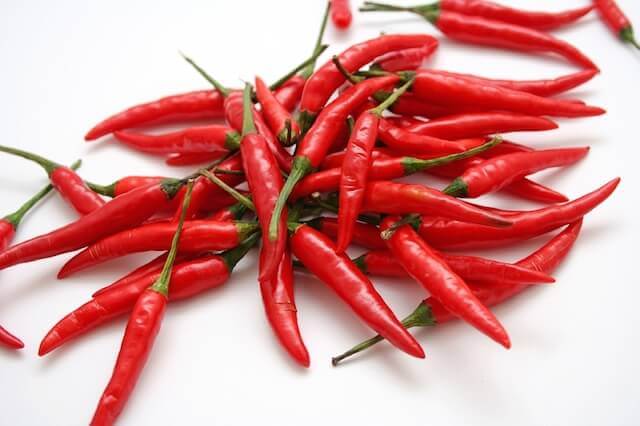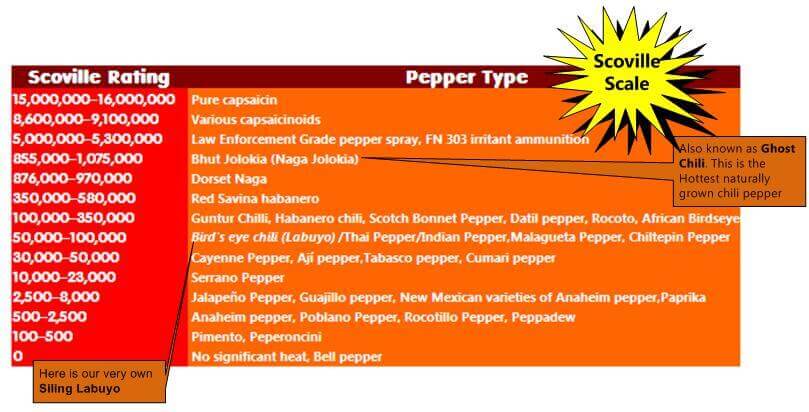How Hot is Your Chili Pepper?
Ever wondered how hot your favorite chili peppers are? Well, I was wondering how hot Siling Labuyo (Asian Bird’s eye chili) was and how it does compared to the other chilies in the world. All the while, I was thinking that the smaller the size of a chili pepper, the hotter it gets – but I was wrong (my friend who told me that tale was wrong too).
It appears that the piquancy (hotness and spiciness) of a chili pepper can be measured by the amount of capsaicin (which is a chemical compound) that it contains. This means that the higher the capsaicin level of a chili pepper, the hotter and spicier it gets. There is a method in measuring the capsaicin level in chili peppers; this is called the Scoville Organoleptic test. This was named after its creator, Wilbur Scoville. On the other hand, the Scoville Scale is the standard measurement used to categorize the degree of piquancy of chili peppers depending on their capsaicin content. I wouldn’t have learned this if not for Adam Richman’s Man vs. food.
This post may contain affiliate links. Please read our disclosure policy.
Ever wondered how hot your favorite chili peppers are? Well, I was wondering how hot Siling Labuyo (Asian Bird’s eye chili) was and how it does compared to the other chilies in the world. All the while, I was thinking that the smaller the size of a chili pepper, the hotter it gets – but I was wrong (my friend who told me that tale was wrong too).
It appears that the piquancy (hotness and spiciness) of a chili pepper can be measured by the amount of capsaicin (which is a chemical compound) that it contains. This means that the higher the capsaicin level of a chili pepper, the hotter and spicier it gets. There is a method in measuring the capsaicin level in chili peppers; this is called the Scoville Organoleptic test. This was named after its creator, Wilbur Scoville. On the other hand, the Scoville Scale is the standard measurement used to categorize the degree of piquancy of chili peppers depending on their capsaicin content. I wouldn’t have learned this if not for Adam Richman’s Man vs. food.
So, how did Siling Labuyo fair? As you can see, it is somewhere on the average level. It will take 10 times the capsaicin level of Bird’s eye chili to match the hottest naturally grown chili pepper in the world, the Bhut Jolokia or most popularly known as “The Ghost chili”.
I like chili peppers; in fact, I can even chew bird’s eye chili if dared. However, I can’t seem to think of myself chewing the hottest chili in the world – that would be totally insane. At present the hottest chili that I ever had was the Habanero. I guess that that’s the farthest that I will go.
What was the hottest chili pepper that you tasted so far? Care to share your experience?



Matt Kay says
Good article and accurate information. I see many articles about the Scoville scale and many times people explain it incorrectly.
I’m with you regarding the Bhut Jolokia. I don’t know if I’m ready to eat a whole Bhut Jolokia pepper yet but I eat Habaneros on a regular basis. Spicy food is a lot of fun and I’m absolutely addicted to it.
Cheers!
Matt Kay
franz says
i’m pinoy and from paranaque btw. =D
franz says
Hello, I grow my own peppers. I have several varieties growing. including the bhut jolokia. =D
don’t have pods at the moment but i have a ton of seedlings. only started a couple months ago.
pawlo says
sir where can i get these bhut jolokia or where can i buy thse plants thanks
franz says
try thehippyseedcompany.com
it’s an australian based and australian owned company. neil is the guy that owns it. he’s real nice and real cool to deal with.
takes about 2-3 weeks after your order will arrive. he’s got tons of other pepper varieties growing. so you’ll get your money’s worth. his prices are quite reasonable too.